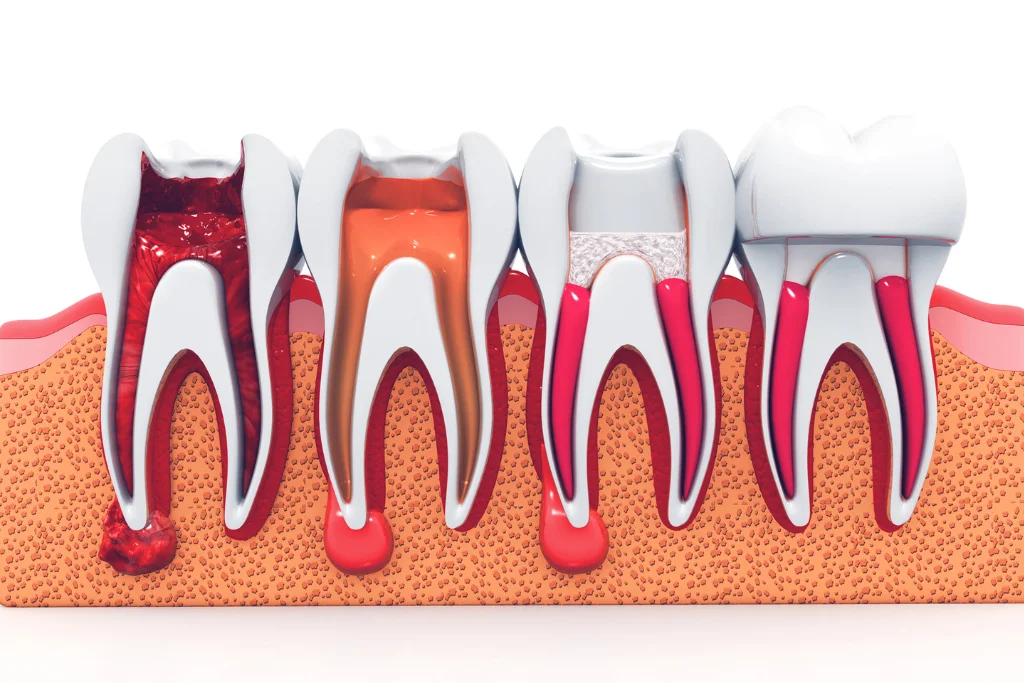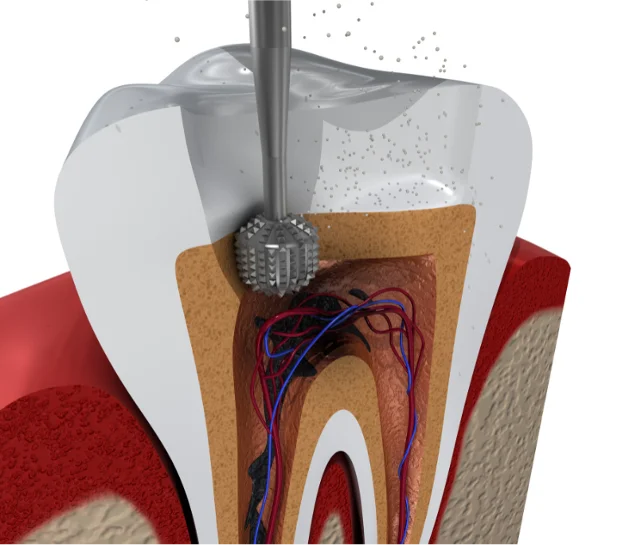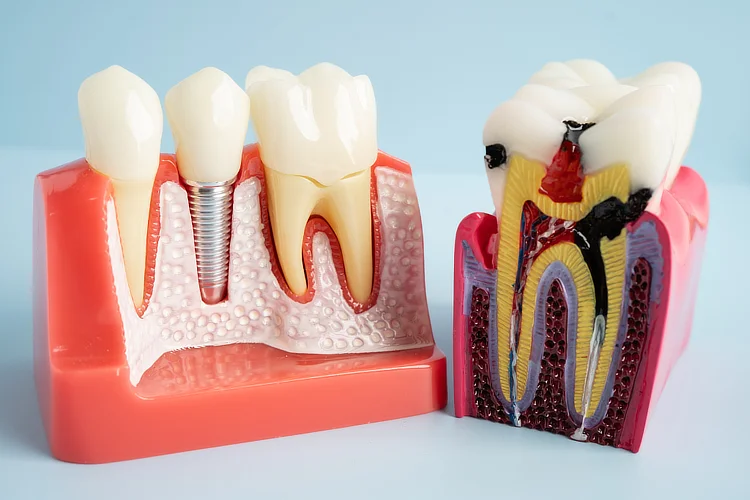Root Canal Treatment Singapore
| Treatment | Root Canal |
| Purpose | To remove infection and preserve a natural tooth by cleaning and sealing the root canals, followed by restoration to maintain strength, function, and appearance |
| Price | From $708.50 NETT |
| Treatment Duration | Root canal procedure typically completed in 2 to 4 visits depending on tooth complexity, with additional visits often required for the final restoration such as a crown or filling |
| How to Book | Book via WhatsApp: 9667 1828 or Email: hello@truedental.sg |
| Clinic Location | 728 Ang Mo Kio Avenue 6, #01-4228, Singapore 560728 |
What Is a Root Canal?
Root canal treatment is a dental procedure that removes inflamed
or infected pulp from inside a tooth. The hollow space inside the root canals of
the tooth, where the nerves and blood vessels are located, is carefully cleaned and sealed to
prevent bacteria from re-entering.
The purpose of the treatment is to relieve pain, stop infection from spreading, and
preserve the natural tooth rather than extracting it. By saving the tooth, you
maintain proper chewing function and help prevent neighbouring teeth from shifting out of place.
After root canal treatment, the tooth usually requires a filling or crown to restore strength
and function.

When Do You Need a Root Canal?
Root canal treatment may be needed when the pulp inside a tooth becomes damaged or infected, often due
to deep decay, repeated dental work that irritates the pulp, cracks, trauma, or advanced
gum disease.
Common signs that treatment may be required include:
- Persistent toothache or sharp pain when chewing
- Sensitivity to hot or cold that lingers after exposure
- Formation of a dental abscess, which is a pocket of pus caused by infection
- Swelling of the gums near the affected tooth
- Darkening or discolouration of the tooth
WhatsApp Us Now
How Is Root Canal Treatment Performed?
Root canal treatment is carried out in several steps to carefully remove infection and restore tooth function. The general procedure includes:
- Examination and diagnosis – The tooth and surrounding gums are examined for signs of infection, and X-rays may be taken to assess the extent of damage.
- Anaesthesia and isolation – Local anaesthetic is given, and a rubber dam is placed around the tooth to keep it dry and sterile.
- Access and cleaning – A small opening is made in the top part of the tooth to reach the pulp chamber. The infected tissue is removed, and the canals are cleaned and shaped.
- Filling and sealing – The root canals are filled with a specialised material called gutta-percha or with bioceramics to seal the space and prevent bacteria from re-entering.
- Restoration – A crown or filling is placed to protect the tooth and restore function. For back teeth, a crown is often recommended to provide extra strength for heavier chewing forces.

How Long Does a Root Canal Procedure Take?
Root canal treatment, including the final restoration, usually takes 2 to 5 visits in
total. Each visit lasts about 30 to 90 minutes depending on the tooth and
complexity of the case. Severely infected teeth may also require multiple visits before the infection
can be resolved.
Front teeth (incisors and canines at the front of the mouth) can be treated in one to two appointments
plus a follow-up for the restoration, while premolars (teeth just behind the canines) and molars (back
chewing teeth) may need longer sessions and additional visits for a crown.
What to Expect After Root Canal Treatment?
After root canal treatment, it is common to experience mild tenderness or sensitivity around the tooth
for a few days, which usually improves with time. The treated tooth may feel slightly different from
neighbouring teeth until the final restoration is placed.
Chewing should be avoided on the treated side until the tooth has been permanently restored. Once this
is completed, a root canal-treated tooth can function normally and last for many years when well
maintained.
However, if pain, swelling, or sensitivity worsens instead of improving, or if new symptoms such as pus
discharge or fever appear, it is important to consult your dentist, as these signs may indicate that the
infection has not fully resolved or that further treatment is required.
Tips on Root Canal Treatment Aftercare
Caring for your tooth properly after a root canal helps support healing and keeps the treated tooth strong and healthy. Some useful aftercare tips include:
| Timeline | Aftercare Tips |
|---|---|
| After root canal procedure | Take medication as prescribed, such as paracetamol or ibuprofen for pain relief or antibiotics if recommended, to manage discomfort and reduce infection risk. Avoid chewing on the treated side until healing has started. |
| First few days (24 to 72 hours) | Continue gentle oral hygiene by brushing and flossing carefully. Eat soft foods such as rice, yoghurt, or soups if the tooth feels tender. |
| After the final restoration | Chew normally but avoid excessively hard or sticky foods that may damage the crown or filling. Maintain consistent oral hygiene to protect the restored tooth. |
| Long-term | Attend follow-up visits and routine check-ups to ensure the tooth remains healthy and functional. |
Remember to also keep up with regular dental visits, as they allow early detection of any issues and help protect the long-term success of your root canal treatment.
How Much Does Root Canal Treatment Cost in Singapore?
At True Dental Studio, our prices for root canal and related-services are as follows:
| Treatment | Price* |
|---|---|
| Consultation | $27.25 to $65.40 |
| Second Opinion Consultation | $27.25 to $65.40 |
| Dental X-ray | From $38.15 |
| Root Canal Treatment | From $708.50 |
| Dental Filling | From $98.10 to $272.50 |
| Dental Crown & Bridge (inclusive of all laboratory fees) | From $1,199 |
*Prices are NETT and inclusive of GST.
Can MediSave be Used for Root Canal Treatment?
Root canal treatment is not claimable under MediSave in Singapore, as it is classified
as a non-surgical procedure. However, subsidies may be available under CHAS (Community
Health Assist Scheme) or the Pioneer Generation scheme, depending on eligibility.
Some private dental insurance plans may also cover part of the cost, so it is advisable to confirm the
details directly with your insurance provider.
What Are Alternatives to Root Canal Treatment?
The main alternative to root canal treatment is tooth extraction, which is required when a tooth
is too severely damaged or infected to be saved with root canal treatment.
Extraction removes the tooth entirely, but this leaves a gap that often requires replacement
with a dental implant, bridge, or denture to restore chewing function and
appearance.
If infection persists even after root canal treatment, further options such as root canal
retreatment or endodontic surgery (for
example, an apicoectomy) may also be considered. Each
choice has its own benefits and limitations, so a thorough discussion with a dentist helps
determine the most suitable treatment.

How Do I Book a Root Canal Appointment?
Book Root Canal Appointment
Book NowEnquire More Through Email
Email Us NowEnquire More Through WhatsApp
WhatsApp Us NowWhy Choose True Dental Studio?
Friendly Dentist and Team
Our team treats each and every patient to the best of our ability. This is the reason why entire families have continued their dental care with True Dental Studio for many years, from all over Singapore.
Minimal Discomfort
At True Dental, it is our commitment to ensure our patients are kept as comfortable as possible. We aim to minimize discomfort, if any, for our patients.
Affordable Treatments
We believe in pricing quality treatments at a competitive rate. We are transparent and upfront with our treatment costs.
Our Smile Scorecard
Frequently Asked Questions
A root canal preserves the natural tooth by removing infected pulp and sealing the canals, while a dental implant replaces a tooth that has been extracted. Root canals are usually recommended when the tooth can still be saved, whereas implants are considered when the tooth is beyond repair. Both options restore chewing function, but retaining the natural tooth is generally preferred when possible. It is advisable to consult a dentist to assess which treatment suits your condition.
Root canal treatment in Chinese is commonly referred to as 根管治疗 (gēn guǎn zhì liáo). This term is widely used in Chinese-language dental contexts and literally translates to “root canal therapy,” describing the process of cleaning, disinfecting, and sealing the canals inside a tooth to stop infection and preserve the natural structure.
Choosing between a root canal and an implant depends on whether the natural tooth can be preserved. Root canal treatment allows the tooth to remain functional, while implants are used when a tooth is removed and must be replaced. Both have advantages, including long-term durability when done properly. Consulting a dentist can help determine whether saving the tooth or replacing it provides the most suitable outcome for your situation.
Symptoms of a failed root canal or complications after extraction can include persistent pain, swelling, gum boils, or new abscesses near the treated area. In some cases, lingering sensitivity or discomfort when chewing may signal that infection remains or has returned. These symptoms vary in severity and should not be ignored. Consulting your dentist promptly helps determine whether retreatment, further surgery, or alternative management is required.
A gum boil after root canal treatment is a pimple-like swelling on the gums caused by pus from infection, usually indicating that bacteria remain near the tooth root. Gum boils rarely heal on their own because the source of infection often persists. While they may come and go, professional treatment is usually required to resolve the underlying issue. It is advisable to consult your dentist promptly if you notice such swelling.
Root canal treatment costs in Singapore vary depending on the clinic, the type of tooth treated, and the complexity of the procedure. Prices may be reduced for eligible patients under CHAS or Pioneer Generation subsidies. At True Dental Studio, root canal treatment starts from $708.50, with consultations ranging from $27.25 to $65.40, excluding restorative work such as crowns or fillings.
A crown is not always required after a root canal, but it is commonly recommended for premolars (teeth just behind the canines) and molars (the back chewing teeth) because these teeth bear heavy forces and are more prone to fracture. Front teeth may only need a filling if the structure remains strong. The decision depends on the tooth’s location, condition, and extent of damage. It is advisable to consult your dentist to determine the most appropriate restoration.
After a root canal, you should follow your dentist’s instructions, which may include taking prescribed medication, keeping up gentle oral hygiene, and avoiding chewing on the treated side until the permanent restoration, such as a filling or crown, is placed. Soft foods are recommended if the tooth feels tender. Once the final restoration is fitted, normal chewing can gradually resume. Attending follow-up visits helps ensure the tooth heals well and remains functional.
You can usually eat a few hours after a root canal once the anaesthesia has worn off, but soft foods such as rice, yoghurt, or soups are recommended in the first few days to reduce strain on the tooth. Hard, sticky, or crunchy foods should be avoided until the permanent restoration, such as a crown or filling, is placed, especially for back teeth that handle heavier chewing. Eating normally can resume once the tooth is fully restored. Always follow your dentist’s instructions regarding food after your procedure.
The disadvantages of root canal treatment include the risk of the tooth becoming more fragile and requiring a crown, the possibility of multiple visits in complex cases, and the need for retreatment if infection persists. Some patients may also experience temporary tenderness or discomfort after the procedure. While these limitations exist, root canal treatment is widely considered a reliable way to relieve pain and preserve a natural tooth. If you are concerned about these risks, it is advisable to discuss them with your dentist.
A root canal can last many years when followed by proper restoration and good oral hygiene. Success rates are generally high, especially when a crown is placed on back teeth to protect against fracture. However, longevity depends on factors such as the severity of initial infection, the quality of the restoration, and ongoing dental care. Regular check-ups and maintenance play an important role in keeping a root canal-treated tooth functional over the long term.
It is uncommon to experience significant pain months after a root canal once healing is complete, but some people may feel occasional mild sensitivity due to changes in the surrounding tissues. Persistent or worsening pain could indicate reinfection, a cracked tooth, or issues with the restoration. Consulting your dentist for an examination is advisable if discomfort continues, as early management improves the chances of saving the tooth and preventing further complications.
Both root canal and implant procedures are carried out under local anaesthesia, so the procedures themselves are generally well tolerated. Some people report temporary discomfort after either treatment, though pain levels vary depending on the complexity of the case and personal healing response. Root canal treatment may involve short-term tenderness, while implants can cause soreness during the surgical recovery period.
A root canal treats infection deep inside a tooth by removing diseased pulp and sealing the canals, whereas a filling repairs more superficial cavities caused by tooth decay. Fillings are suitable for minor to moderate decay that does not reach the pulp, while root canal treatment is needed when the pulp is inflamed or infected. Both procedures aim to preserve the tooth, but they address different levels of damage and require different techniques.
Root canal treatment is often considered worthwhile because it allows the natural tooth to be preserved, maintaining normal function and preventing the need for extraction and replacement. While costs can be significant, replacing a missing tooth with an implant or bridge may be more expensive over time. The decision depends on the tooth’s condition, long-term outlook, and financial considerations. Consulting your dentist helps determine whether a root canal is the most suitable choice.
Signs you may need a root canal include persistent toothache, lingering sensitivity to hot or cold, gum swelling, darkening of the tooth, or formation of a dental abscess. These symptoms suggest pulp infection or damage inside the tooth. In some cases, there may be no obvious signs, and the need for treatment is identified on X-rays. It is advisable to consult your dentist promptly if these symptoms appear to prevent further complications.
Avoiding or delaying a root canal allows infection to progress, which may cause worsening pain, swelling, abscess formation, or spread of infection to surrounding bone and tissues. The affected tooth may eventually become unsalvageable and require extraction. Early treatment helps preserve the natural tooth and reduces the risk of more extensive problems. If you are experiencing symptoms such as persistent pain or swelling, it is advisable to consult a dentist to determine whether urgent treatment is required.
Root canal treatment cannot be paid for using CPF MediSave in Singapore, as it is classified as a non-surgical dental procedure. MediSave is generally applied to surgical treatments such as wisdom tooth surgery. However, subsidies under CHAS or the Pioneer Generation scheme may be available, depending on eligibility. Some private dental insurance plans may also provide partial coverage. It is advisable to confirm your coverage with your dentist or insurance provider before treatment.
Root canal treatment can be relatively costly because it is a technically complex procedure that involves multiple steps, specialised instruments, and often more than one visit. The cost also reflects the need for X-rays, infection control, and a final restoration such as a crown to ensure long-term function. Fees vary depending on tooth type and clinic setting, though subsidies under CHAS or the Pioneer Generation scheme may help reduce costs for eligible patients.
A root canal is not usually painful during the procedure, as local anaesthesia is used to numb the tooth. Some tenderness or sensitivity is common in the days following treatment, but this typically improves with time and can be managed with pain relief. Modern techniques have made the experience more comfortable than many expect. Consulting your dentist allows you to discuss what to anticipate and how discomfort will be managed during recovery.
Whether a root canal or extraction is better depends on the condition of the tooth. A root canal is generally preferred if the tooth can be saved, as it preserves natural function and appearance. Extraction is necessary when the tooth is too severely damaged or infected to treat, but it usually requires replacement with an implant, bridge, or denture. It is advisable to consult your dentist to weigh the benefits and limitations of each option.
